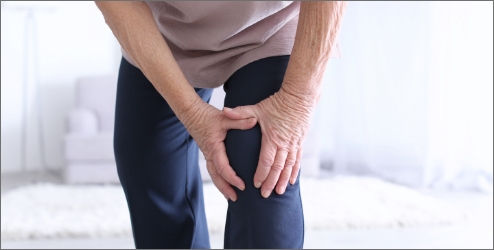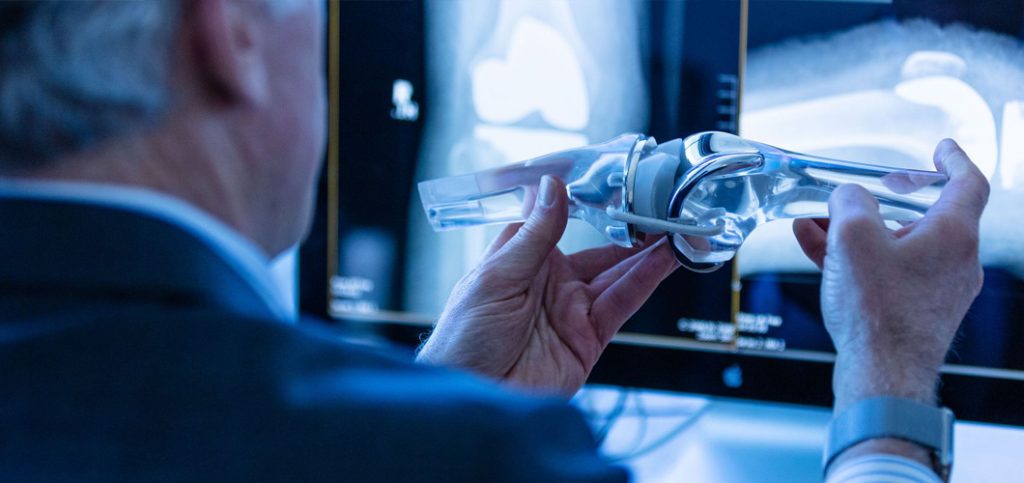KNEE ARTHRITIS
The knee joint is commonly affected by arthritis. Because it is a significant weight-bearing joint with a pivotal role in may activities, it can have a considerable impact on a person’s life. Arthritis is a progressive disease. However, it comes on over years and decades. When the cartilage is completely lost, the person may reach the stage of having “bone on bone”.
Many conditions lead to cartilage damage and osteoarthritis. However, most cases are idiopathic, which means that there is no specific cause. There is probably a genetic component to this idiopathic variety and that joints other than the knee are commonly involved (hips and hand). Knee injuries can damage the cartilage. Injuries include fractures that extend into the joint and fractures of the leg bones that heal in a “crooked” position. Ligament and meniscal tears can also predispose to arthritis. There are also a group of diseases that cause inflammation of a joint such as Rheumatoid Arthritis that can lead to cartilage damage. Arthritis is commoner as a person ages, but it is not an inevitable consequence of ageing.

SYMPTOMS OF KNEE ARTHRITIS

- Swelling
- Deformity
- “Mechanical” symptoms such as catching
- Loss of movement, including the inability to straighten the leg
- entirely
- Limp
KNEE ARTHRITIS DIAGNOSIS
The diagnosis of osteoarthritis of the knee can be made based on the person’s age, symptoms and the findings when a doctor examines your knee.
However, imaging of the knee is required to confirm the diagnosis. Although the severity of the symptoms is vital in assessing the stage of the arthritis, imaging plays an important role too. X-Rays, especially weight-bearing X-Rays, show characteristic changes. The most significant changes are a reduced gap between the two bones (indicative of the extent of cartilage damage) and the presence of bone spurs (osteophytes) that project out from the bones. An MRI is not required to confirm the presence of arthritis but will demonstrate characteristic features.
It is essential to know that as yet the cartilage damage cannot be repaired. The cartilage loss is progressive but occurs over the years to decades. As mentioned above, and it needs to be stressed enough, the pain from the arthritis is intermittent.
Call us on (03) 5223 3151 Book an appointment today.
What are the four stages of knee osteoarthritis?
Osteoarthritis is classified based on the severity of the knee pain or symptoms. Below are the four stages of osteoarthritis of the knee (excluding stage 0, which means the knees are healthy):
Stage 1: Minor
Being on Stage 1 means that you’ve developed some wear and tear in your knee joints. Bone spurs may also grow at the end of your joints. There’s little to no pain or discomfort, and if there’s any, you probably won’t notice it.
If you don’t have a medical history or genetic predisposition to having osteoarthritis, you may not need any special treatment at all. However, you may only be asked to perform regular exercise to help prevent worsening symptoms.
Stage 2: Mild
This stage is when you start to experience a low level of joint stiffness and pain. You will feel some discomfort when sitting for long periods; sometimes, upon waking up, or after performing exercise.
Diagnostic/magnetic resonance imaging may show more bone spurs, although there is still enough cartilage left to prevent bone friction. Though the cartilage and soft tissues are still healthy, the proteolytic breakdown of the cartilage matrix brought on by overproduction of enzymes has already begun.
To manage Stage 1 knee arthritis, your doctor will encourage you to follow a plan to slow down, if not completely prevent, the progression of the disease. The patient may not need medications at this point, and can instead follow a regimen of strength and flexibility training exercises. Knee sleeve, braces and active supports may be used to provide stability and prevent knee stress and injury.
Stage 3: Moderate
During the moderate stage of the progression of the knee arthritis, you’ll feel more and frequent pain during high impact movements or positions that put some pressure on your knees, such as running, going on long walks, kneeling or squatting; as well as during periods of long inactivity, such as after lying in bed overnight during sleep. Popping and snapping sounds may also be observed as you walk or move. The intensity of pain has increased during this stage as the cartilage that cushions the bones has eroded. This stage will have many bone spur growths; lesions and fibrillation are also present.
Pain relievers may be prescribed to reduce pain. Advanced therapies may be needed, such as viscosupplementation, for patients who have not responded well to physical therapy.
Stage 4: Severe
Stage 4 refers to severe osteoarthritis. Patients in this stage experience excruciating pain, as the space between the bone joints have been significantly reduced, leading to a damaged cartilage. Extreme pain due to inflammation might be felt when walking or when moving the affected joints. Simple chores and activities that used to be easy can pose challenging to Stage 4 osteoarthritis sufferers. Surgery may be the only option for this type of knee arthritis.
What happens if knee arthritis is left untreated?
Left untreated, knee arthritis will impact your ability to take care of yourself and perform everyday activities. It may also result in deformities of the joints and can cause permanent damage to your knee anatomy. It will also become painful and uncomfortable to walk or even work. Once the disease has progressed to a severe stage, you may even need total joint, or even, knee replacement.

What can be done for arthritis of the knee?
Osteoarthritis can be debilitating if not treated or managed based on a proper diagnosis. Oftentimes, it leads to total knee replacement surgery, which is still the gold standard to relieve pain from arthritis.
When not in its severe form, knee arthritis can still be managed with minimally invasive options such as physical therapy or rehabilitation, medication, corticosteroid or hyaluronic acid injections, arthroscopic surgery, and osteotomy. We explain some of the advanced knee arthritis treatments that we recommend and/or offer in a dedicated page that is linked below.

FAQs:
There is no cure for osteoarthritis; however, the condition does not always progress aggressively or get worse over time, depending on how you manage it. Fortunately, there are a number of treatment options for managing osteoarthritis that can provide you pain relief, such as physical therapy, maintaining a healthy weight, regular exercise, and some over the counter medications. If your symptoms get worse, Dr Brown can always help you get on the road to recovery so you can live a full and active life.
Walking is absolutely a good exercise for those suffering from knee arthritis. It is a low-impact activity that does not put unnecessary stress on your joints. It also helps increase your knee’s range of motions, preventing it from becoming extremely stiff.
While walking may hurt at first, once you get used to it, your legs will get stronger. Walking lubricates your joints and cartilage which help ease your symptoms.
Arthritis usually manifests when you reach 50 and above, although it can occur in younger people as well. Many younger patients from their early 20s and 30s, and even teens can suffer from the condition.
It is hard to ascertain how long one can live with osteoarthritis as symptoms and severity vary on a case-to-case basis per patient. However, a study published early this year found that the average survival rate for healthy adults with arthritis is between 77 and 82 years old. Patients approximately live with the disease for 30 years. However, with proper treatment, life expectancy can be improved.
Osteoarthritis, as it progresses over time, can lead to a long term disability. In many nations, including Australia, it is considered a disability. Many people suffering from arthritis experience debilitating symptoms, such as excruciating joint pain that can limit their ability to work.

